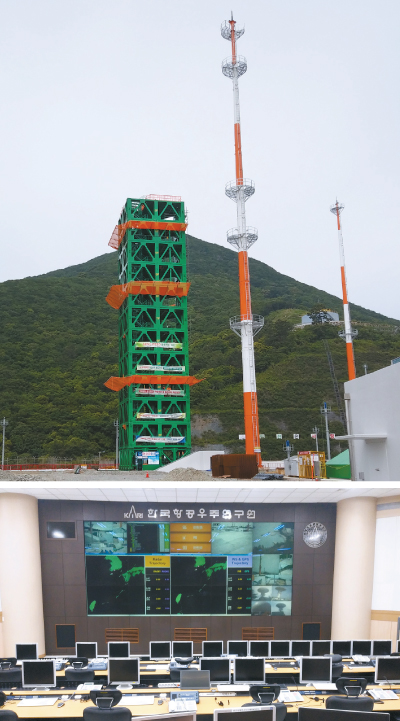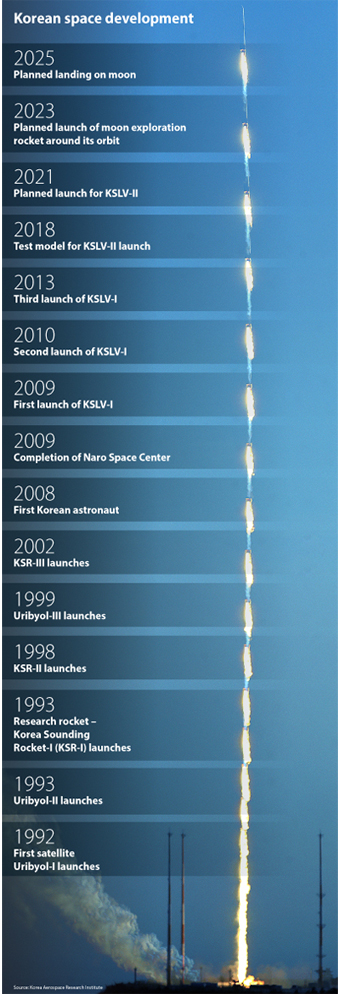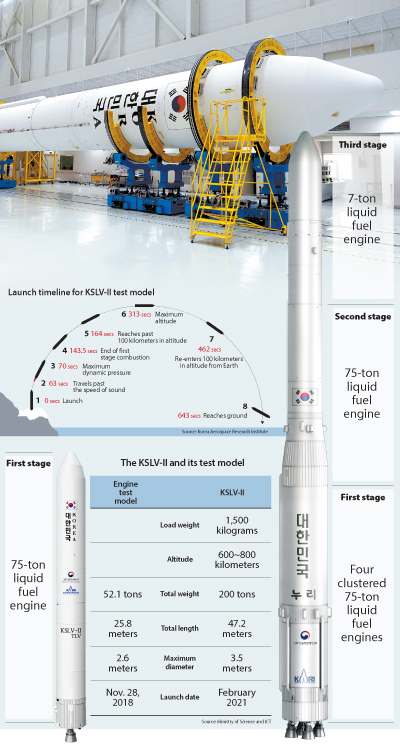Space: The final frontier, but not for much longer

Top: The launch complex for the KSLV-II is being constructed inside the Naro Space Center in Goheung County, South Jeolla, on Saturday. The complex will launch the KSLV-II in February 2021. Above: A view of the Mission Director Center inside the Naro Space Center.[KO JUN-TAE]
With the target date for the launch of the Korea Satellite Launch Vehicle II (KSLV-II) just 19 months away, experts are busy testing turbo engines and preparing a brand new launch complex.
The Korea JoongAng Daily got an exclusive look at the Naro Space Center, its launch complex and related facilities for the KSLV-II, also known as Nuri, on June 1.
Positioned on the southern edge of Naro Island in Goheung County, South Jeolla, the launchpad is far from complete at the moment, but the basic structures are still visible. In the center of three enormous lightning rods reaching a little more than 50 meters (164 feet) in height stands the empty, green skeleton of a 12-story fuel supply tower.
The fuel tower will play a pivotal role when Nuri punches a hole in the sky a little less than two years from now. It will pump the engines of the KSLV-II full of liquid fuel just a few hours before launch time.
The three-stage rocket will take a 1,500-kilogram (3,304-pound) payload up 600-800 kilometers (372-497 miles) above the earth. It will be Korea’s second orbital launch vehicle after the KSLV-I. The final product will stand 47.2 meters tall with a liftoff mass of 200 tons and a diameter of 3.5 meters.
“If successful, it will be a huge step forward for Korea’s space program,” said Lee Kyoo-su, director of the public relations and media cooperation division at the Korea Aerospace Research Institute (KARI).
But all that is possible only if the KSLV-II launches at 8 kilometers per second, or 28,800 kilometers per hour. If the vehicle flies at a lower speed than that, it will never escape Earth’s gravity and will eventually nosedive back to the planet’s surface or simply burn up in mid-air.
Several construction workers were even working on Saturday when this reporter toured the satellite launchpad inside the Naro Space Center. Employees came in on Saturday after heavy rain on Friday prevented them from reaching their daily target.
There’s a reason behind the rush - the Naro Space Center and its employees are carrying the ambitions of not just KARI, but also the Korean government.

Weekends and holidays hardly mean anything for those working at the Naro Space Center, as the government has set highly ambitious goals for the project.
Under a timeline set by the Ministry of Science and ICT and KARI, Korea aims to be capable of launching small- and medium-sized satellites with its own technology by 2030. Four years later, it aims to create its own navigation satellite system and release a spacecraft with astronauts in it to tour a minor planet by 2035.
Ultimately, by 2040, the government wants to be using exclusively Korean satellites with its own technology.
While all these goals may sound far-fetched, there is a reason to be confident - Korea obtained rocket technology from Russia while working together for the launch of the KSLV-I, also known as the Naro, named after the island and its space center, in 2013.
After two failures in 2009 and 2010, the 140-ton KSLV-I was successfully launched on the third try on Jan. 30, 2013, and lofted its satellite into orbit, marking Korea’s debut as a successful orbital rocket launching country.
The collaboration between Korea’s fledgling aerospace industry and Russia goes back to 2001, the year Korea joined the Missile Technology Control Regime. The regime’s member states agreed not to export their unmanned aerial vehicle technology to other countries. Korea joined the regime to ensure the world that it will not be developing its own nuclear missiles that would critically damage the uneasy peace on the Korean Peninsula.
However, the regime also paved the way for Korea to join the global space race. The country became free of an agreement it reached with the United States in 1979 that comprehensively blocked any research and development into making its own missiles and space rockets. The agreement had limited Korean missiles to only reach 111.6 miles in distance.
Before 2001, Korea essentially had no technology whatsoever capable of sending anything into the Earth’s orbit, except in making satellites. Korea launched its first satellite, the Uribyol-I, into space on Europe’s Ariane launch vehicle in 1992.
But Korea already had grand plans to send its own rockets up even prior to joining the international missile regime. In 1996, the government announced the so-called KSLV initiative, which set 2005 as the target year for the launch of KSLV-I, 2010 for KSLV-II and 2015 for KSLV-III.
Of course, the target dates were delayed multiple times and the KSLV-II, originally planned for nine years ago, is still being developed.
The successful completion of the KSLV-II is crucial not only because the country missed its original deadline, but also because many have downplayed the launch of the KSLV-I as only a “half a success.”
The KSLV-I finally reached orbit on its third try thanks to a push from the main launch vehicle, manufactured and supplied by the Khrunichev Space Center in Moscow. Korea only developed the second-stage vehicle, which carried a small satellite and a small booster fuel engine.
Those who downplay the launch of the KSLV-I say Korea still lags behind other Asian competitors when it comes to launch vehicles, as Japan and China have already launched rockets into orbit with their own technologies in the 1970s, followed by India in the 1980s.

Nov. 28 last year was a big day for KARI as it was when the successful test of the rocket engine that will be used to power KSLV-II took place, a giant step toward Korea’s goal of sending its own launch vehicle into space.
The suborbital vehicle launched from the Naro Space Center at 4 p.m. and reached an altitude of 75 kilometers above earth. Its 75-ton engine burned for 151 seconds, 11 seconds longer than the targeted time of 140 seconds.
As combustion lasted more than 140 seconds, KARI was able to confirm that the engine operates well and is viable to be equipped in the KSLV-II, scheduled for launch in 2021.
“It was a big moment for us, as we were extremely stressed from the failures of the KSLV-I and numerous delays we had to make prior to the test launch,” said Lee Chul-hyoung, director of the administration and management division at the Naro Space Center. “Some of us cried and celebrated, but the next day we were back on the job to get the KSLV-II ready for February 2021.”
The KSLV-II is divided into three stages. At the very bottom, the first-stage booster will carry four 75-ton engines clustered together to push the rocket through the atmosphere.
The middle part of the rocket is equipped with one 75-ton engine, which already proved its capability last year. It will push itself and the top section after being separated from the first-stage booster a few minutes after launch.
When the rocket, which will carry a satellite, finally breaks free of the earth’s atmosphere, its third stage, it will push further with a 7-ton engine.
The Ministry of Science and ICT said shortly after the test launch that the next three years will mostly be devoted to perfecting the first-stage booster as the operations of the second and third-stage have been verified.
“We have a lot of things to accomplish as the target year approaches,” Lee Chul-hyoung said. “Everything, especially the 75-ton engine, needs to be perfectly ready for this one rocket to reach orbit.”
He added the Naro Space Center has manufactured 22 different versions of the 75-ton fuel engine and conducted dozens of experiments before a model proved effective during the test launch last year.
Contrary to what many believe from watching Hollywood movies, launching the KSLV-II in 2021 will not be as easy as simply pressing a button, Lee said. There are intricate processes that must be executed in a precise order for the launch to successfully get a satellite into orbit.
A few days before the launch date, two radar stations in the Naro Space Center and Jeju Island will begin operating and testing to ensure the KSLV-II is tracked every millisecond of the way after it is launched into the air.
More than 300 specialized facilities beneath the surface of the launch complex will be tested for weeks before the scheduled launch date.
Not to mention, engineers will be checking every nut and bolt of the launch vehicle for weeks before the launch date. They will be hand-screwing every part and repeating the process for numerous days to ensure the KSLV-II doesn’t explode mid-air, Lee Chul-hyoung said.
A few hours before the launch, the fuel tower will supply liquid fuel into all stages of the KSLV-II and monitor any leakage or malfunctions.
When everything is confirmed and ready, the Naro Space Center will activate a 15-minute timer and initiate its last round of checks prior to the launch.
The story behind the center
The Naro Space Center, now a workplace for hundreds of people and home to 53 in-house employees, has greatly boosted the regional economies of Goheung County and South Jeolla.
Since opening across 5.4 million square meters (1,334 acres) of land next to Mount Bongrae, more than 150,000 people have visited the museum attached to the space center every year and slept in dozens of fairly new motels and inns near the facility.
Real-estate prices for properties in the region have more than tripled since the Naro Space Center was completed in 2009. Many schools and other educational institutions often come to the space center for field trips and other recreational activities.
But the island was pretty much empty before the government started constructing the space center in March 2003. Back then, Naro Island had virtually no one and nothing on it except a few dozen farmers and fishermen, said Ock Su-hyun, a senior researcher in the public relations division at KARI.
“There wasn’t even a decent restaurant when people first came to inspect the island,” Ock said. “There wasn’t an inn for inspectors to sleep in during their inspection schedule.”
Naro Island was chosen as the site for the national space center in 2001 as the government was looking for an area in the southern part of the country.
“We initially picked three locations - Jeju Island, Namhae County [in South Gyeongsang] and Goheung County - as possible sites for a space center,” Lee Kyoo-su said. “But we faced fierce opposition from Jeju residents and found out from further analysis that the Namhae area wasn’t suitable for a launch complex.”
The reason inspectors tried to find a site in the southern part of Korea was that rockets need to launch away from highly populated areas and airplane routes.
Although Jeju was the most desired spot for the government, officials had to move forward with Naro Island as Jeju residents were in fierce opposition to the space center being constructed in their area, citing safety concerns.
Since announcing that Naro Island was chosen as the site for the Naro Space Center, officials started negotiating with some residents in the area for relocation, Lee Kyoo-su said. Residents were paid varying amounts to move to a different area in South Jeolla.
Those residents that left the island have a special right to visit the Naro Space Center anytime when the facility is open, Ock added. There were a few people inside the regulated space center when this reporter visited the Naro Space Center last week.
But the island is still home to around 20 households living close to the Naro Space Center. Although some might feel jealous that they have the privilege of watching rockets flying out of the space center from the comfort of their living rooms, not one of them has been able to witness a single rocket being launched.
“Every time we do any test launch or shoot up rockets into the air, local residents are evacuated and sent to a nearby city,” said Lee Kyoo-su. “We take some money out of our budget to send them on a vacation for the days we conduct potentially dangerous experiments. We can always rebuild houses for those residents if any accidents occur, but their lives cannot be substituted by any means.”
The same will be the case for Naro Island residents when the KARI launches the KSLV-II into orbit in 19 months’ time. Local residents won’t be there to see it punch a hole in the sky.
BY KO JUN-TAE [ko.juntae@joongang.co.kr]










with the Korea JoongAng Daily
To write comments, please log in to one of the accounts.
Standards Board Policy (0/250자)